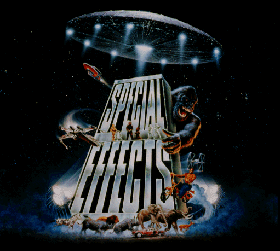 "Special Effects" Celebrates 100 Years of FX in Filmmaking
"Special Effects" Celebrates 100 Years of FX in Filmmaking
Movie special effects come alive
as never before on the Detroit
Science Center's giant IMAX Dome
in the dazzling new film Special
Effects, produced by NOVA/WGBH Boston.
Special Effects
features
eye-popping
visual effects from
four recent motion
pictures using
state-of-the-art fimmaking techniques, including Independence Day, Star
Wars Trilogy Special Edition, Jumanji, and Kazaam. Audiences will also see King
Kong's final battle as well as starship chase scenes choreographed with
original star wars models, newly reshot in the awesome IMAX format at
spectacular scale and resolution.
Nova, the popular PBS science series and producer of IMAX-format films,
was given exclusive large-format access to major film and special effects
studios to produce this behind-the-scenes look at how movie makers achieve
startling and utterly convincing visual effects.
"Special Effects celebrates 100 years of cinema and the technological
achievements that have made special effects a critical part of the
entertainment industry today," says the films producer, Susanne Simpson.
The film follows the innovative effects wizardry that goes into blockbuster
movies, including backstage glimpses of Industrial Light and Magic at work on
Lucasfilm Ltd.'s upcoming Star Wars Trilogy Special Edition, scheduled for a
1997 release to coincide with the 20th anniversary of the original Star Wars.
Special Effects similarly explores the making of Twentieth Century Fox's
summer 1996 motion picture epic Independence Day, Tri-Star's 1995 box
office hit fantasy of a boardgame-come-alive, Jumanji, and Kazaam from
Interscope Communications, Inc. (with effects by Rhythm and Hues, winner of
the 1995 Academy Award for visual effects for Babe) starring Shaquille O'Neal
as a rapping genie with magical powers.
Viewers will also see history repeat itself as King Kong battles airplanes on the
giant screen in a 1990s update of the classic story, newly created in IMAX
exclusively for the film by Hollywood's masters of movie magic.
NOVA is renowned for making science as accessible as it is fascinating, a task
it accomplishes in Special Effects by showing how movie model makers, matte
painters, pyrotechnicians, camera operators, animators, and computer
graphics artists rely on the principles of visual perception to fool the audience.
The film demonstrates how the visual cues we use to orient ourselves in the
real color, form, light, motion and are manipulated to create the
illusion of reality on the screen.
------
NOVA/WGBH Boston is currently in production on Special Effects, a
large format film funded by WGBH with the participation of eighteen U.S. and
international science museums, to be shown in IMAX® and IMAX DOME®
theaters. The film tells the behind-the-scenes story of a group of special
effects filmmakers creating an extraordinary special effects sequence in this
larger-than-life film format. The film begins by showing the early
inventors--the Lumière Brothers, E.J. Marey and Edison--and how motion
picture technology was exploited by artists such as Méliès.
Examples of key concepts in perception, such as persistence of vision and
induced movement, will be used throughout the film to explain how filmmakers
use science to achieve their artistic illusions. The unique concept of this
film is to bring together the history of cinema and the art of filmmaking with
the science of perception.
Most everyone has seen the image of an oversized renegade gorilla atop the
Empire State Building, immortalized in the classic 1930s movie. While audiences
have become jaded towards many visual effects of yesteryear, the masters
of today's blockbuster movies make the impossible seem quite believable.
Special Effects, a new IMAX film being released in July, takes audiences
to Hollywood's back lots (including the studios of George Lucas' Industrial
Light & Magic) to see the science behind Hollywood's magic.
The film profiles some of this year'sp;and and next year'sp;hottest
films including Star Wars Trilogy Special Edition, Independence
Day, Jumanji, and Kazaam. Chromakey technology, forced perspective
and other complicatedp;and sometimes surprisingly simplep;film techniques
produce a variety of stunning visual effects to wow movie audiences. Special
Effects also examines the history of visual effects, including a special
appearance by King Kong.
Included are backstage glimpses of astonishing new effects produced for
the Star Wars Trilogy Special Edition, scheduled for release in 1997.
Although producer George Lucas envisaged these effects when he made the
first Star Wars film in 1977, it is only recently that new technology has
made them possible. Exclusive footage filmed in the IMAX formatp;a special
effect in itselfp;makes the Force more powerful than ever.
Executive Producer Susanne Simpson said of Special Effects, "We
want the film to entertain the audience with great special effects, but
we also want to get them thinking about the perceptual insights that underlie
the illusions, and the human creativity and technical ingenuity that make
them possible."
 "Special Effects" Celebrates 100 Years of FX in Filmmaking
"Special Effects" Celebrates 100 Years of FX in Filmmaking